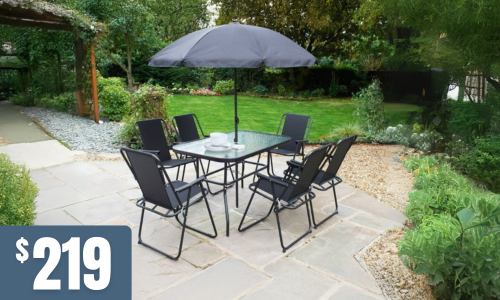Posts tagged with 'eclectic decor'
.jpg) Some trends come and go, but the enduring allure of natural wood furniture remains timeless. Embracing rustic charm, natural wood furniture brings warmth, character, and a connection to nature into our living spaces. Join us on a journey through the world of natural wood, exploring how this elemental material can infuse your home with a rustic charm that is both comforting and stylish.
Some trends come and go, but the enduring allure of natural wood furniture remains timeless. Embracing rustic charm, natural wood furniture brings warmth, character, and a connection to nature into our living spaces. Join us on a journey through the world of natural wood, exploring how this elemental material can infuse your home with a rustic charm that is both comforting and stylish.
The Beauty of Imperfections: Distressed Finishes
One of the key characteristics that define rustic charm is the celebration of imperfections. Embrace natural wood furniture with distressed finishes, where the marks, knots, and variations in grain become part of the design. Whether it's a weathered dining table, a reclaimed wood coffee table, or a barnwood dresser, these pieces tell a story of age and history, adding authenticity and charm to your living space.
Warmth in Every Grain: Natural Wood Textures
The tactile appeal of natural wood textures brings a sense of warmth that is unmatched. Run your fingers over the grain of a solid oak dining table or feel the smoothness of a teak coffee table. Natural wood furniture invites touch, creating an intimate connection with the material. The varied textures, from the ruggedness of oak to the sleekness of maple, add depth and richness to your interiors.
Versatility in Style: Adaptable to Any Aesthetic
Natural wood furniture is incredibly versatile, seamlessly adapting to various design aesthetics. Whether your style is farmhouse, industrial, Scandinavian, or contemporary, there's a place for natural wood. A distressed wooden bookshelf might find a home in a rustic farmhouse setting, while a sleek oak dining table can anchor a modern dining space. The adaptability of natural wood makes it a timeless choice for any interior style.
Earth Tones and Harmony: Bringing Nature Indoors
The earthy tones of natural wood create a harmonious connection with the outdoors, bringing a touch of nature into your home. From the rich browns of mahogany to the lighter hues of pine, natural wood furniture evokes a sense of tranquillity and balance. Pair it with neutral colours, earthy textiles, and indoor greenery to create a cohesive and calming atmosphere in your living spaces.
Timeless Elegance: Classic Wood Furniture Designs
Classic wood furniture designs have stood the test of time, proving that simplicity and quality craftsmanship are enduring virtues. Think about timeless pieces like Windsor chairs, Shaker-style dressers, or spindle-back benches. These classics not only exude elegance but also serve as investment pieces that can be passed down through generations, carrying with them the stories of family and home.
Mixing and Matching: Creating Eclectic Spaces
Embrace the art of mixing and matching with natural wood furniture. Combine different wood tones and textures to create an eclectic and dynamic living space. A dark walnut coffee table might sit alongside a light oak sideboard, creating visual interest and a lived-in feel. The eclectic mix of natural wood pieces adds personality and character, making your home uniquely yours.
Crafting a Home with Rustic Charm
Embracing natural wood furniture goes beyond following a trend; it's about crafting a home with enduring rustic charm. The beauty of imperfections, the warmth of natural textures, and the adaptability to various styles make natural wood a staple in interior design. Whether you opt for distressed finishes, classic designs, or an eclectic mix, the timeless appeal of natural wood furniture invites you to create a home that is not just stylish but also authentically yours. So, let the rustic charm of natural wood infuse your living spaces with warmth, character, and a connection to the beauty of the natural world.
.jpg) In the ever-evolving world of interior design, styles from the past often resurface, and the 60s and 70s are no exception. The swinging 60s and funky 70s were defining decades for furniture trends, characterised by bold colours, unconventional shapes, and a free-spirited approach to design. In this article, we'll embark on a nostalgic journey and explore the resurgence of 60s and 70s furniture trends, highlighting how these retro styles are experiencing a vibrant revival in contemporary British homes.
In the ever-evolving world of interior design, styles from the past often resurface, and the 60s and 70s are no exception. The swinging 60s and funky 70s were defining decades for furniture trends, characterised by bold colours, unconventional shapes, and a free-spirited approach to design. In this article, we'll embark on a nostalgic journey and explore the resurgence of 60s and 70s furniture trends, highlighting how these retro styles are experiencing a vibrant revival in contemporary British homes.
The Swinging 60s: A Burst of Colour and Innovation:
The 60s were marked by a spirit of rebellion and creativity, and this ethos was reflected in furniture design. Here are some key elements of 60s furniture trends:
- Pop Art Influence: The pop art movement had a profound impact on furniture, with its bold use of primary colours and geometric patterns. Furniture pieces often featured eye-catching, vibrant hues.
- Modular Furniture: Modular and multifunctional furniture was popular in the 60s, allowing for adaptability and a sense of individuality in home decor.
- Organic Shapes: The era embraced organic, curvilinear shapes in furniture design, from egg-shaped chairs to circular coffee tables.
- Bold Patterns: Striking patterns like florals, abstracts, and polka dots adorned upholstery, cushions, and curtains.
- Iconic Designs: The 60s introduced iconic furniture pieces, such as the Eames Lounge Chair, the Egg Chair, and the Tulip Table, which remain highly sought after today.
The Funky 70s: An Era of Groovy Style:
The 70s brought a groovy and eclectic style to furniture design. Here are some defining characteristics of 70s furniture trends:
- Earth Tones: Earthy colours like avocado green, harvest gold, and burnt orange dominated furniture and decor palettes.
- Wood and Wicker: Furniture materials such as dark wood and wicker were popular, adding warmth and texture to interiors.
- Shag Carpets: Shaggy, deep-pile carpets were a common choice, adding a tactile and retro feel to living spaces.
- Bohemian Influence: The 70s saw the rise of bohemian and hippie aesthetics, with macramé, tapestries, and low seating options becoming fashionable.
- Open Floor Plans: The 70s embraced open floor plans, and furniture designs often aimed to create versatile living spaces.
The Revival of Retro:
So, why are these retro styles making a comeback in contemporary British homes? Here are some reasons:
- Nostalgia: Many people have fond memories of the 60s and 70s, and incorporating elements of these eras into their homes evokes nostalgia and a sense of comfort.
- Timeless Appeal: The bold and unique designs of the 60s and 70s possess a timeless quality that continues to captivate homeowners and designers alike.
- Mixing Eras: Contemporary interior design often involves blending different eras and styles. Retro pieces can add character and a touch of whimsy to modern interiors.
Embracing Retro in Contemporary Decor:
To incorporate 60s and 70s furniture trends into your contemporary decor:
- Choose Statement Pieces: Select iconic retro furniture pieces like a colourful Eames chair or a funky shag rug as statement items.
- Blend with Modern: Pair retro furniture with modern elements to create a balanced and eclectic look.
- Use Retro Accessories: Incorporate retro accessories like lava lamps, vintage posters, or bold-patterned cushions to infuse a touch of nostalgia.
The resurgence of 60s and 70s furniture trends offers an exciting opportunity to embrace the past while infusing your British home with a burst of colour, creativity, and a sense of fun. Whether you opt for a single retro statement piece or go all out with a full-on throwback theme, these trends are a groovy way to add character and personality to your contemporary decor. So, let's dance to the retro revival and celebrate the enduring appeal of these iconic decades in British interior design.




.jpeg)

 (3).jpeg)
